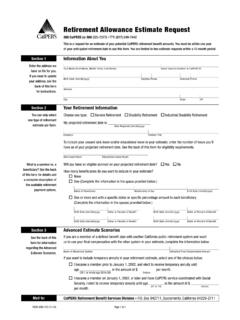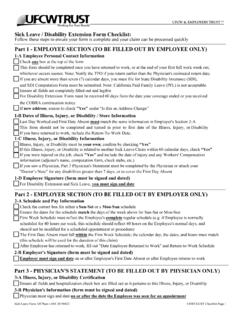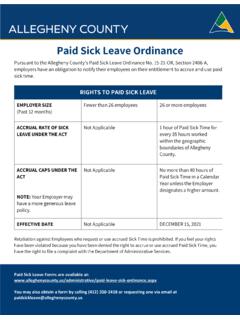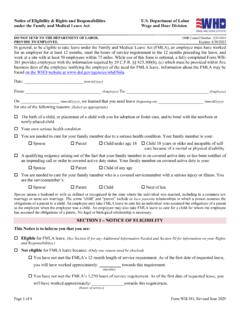Transcription of Note: The draft you are looking for begins on the next ...
1 Caution: draft NOT FOR FILING This is an early release draft of an IRS tax form, instructions, or publication, which the IRS is providing for your information as a courtesy. Do not file draft forms. Also, do not rely on draft forms, instructions, and publications for filing. We generally do not release drafts of forms until we believe we have incorporated all changes. However, unexpected issues sometimes arise, or legislation is passed, necessitating a change to a draft form. In addition, forms generally are subject to OMB approval before they can be officially released.
2 Drafts of instructions and publications usually have at least some changes before being officially released. Early release drafts are at , and may remain there even after the final release is posted at All information about all forms, instructions, and pubs is at Almost every form and publication also has its own page on For example, the Form 1040 page is at ; the Publication 17 page is at ; the Form W-4 page is at ; and the Schedule A (Form 1040) page is at If typing in a link above instead of clicking on it, be sure to type the link into the address bar of your browser, not in a Search box.
3 Note that these are friendly shortcut links that will automatically go to the actual link for the page. If you wish, you can submit comments about draft or final forms, instructions, or publications at We cannot respond to all comments due to the high volume we receive. Please note that we may not be able to consider many suggestions until the subsequent revision of the product. September 19, 2018 draft AS OFInstructions for Form 941(Rev. January 2019)Employer's QUARTERLY Federal Tax ReturnDepartment of the TreasuryInternal Revenue ServiceSection references are to the Internal Revenue Code unless otherwise DevelopmentsFor the latest information about developments related to Form 941 and its instructions, such as legislation enacted after they were published, go to 's NewNew filing addresses.
4 For the quarter ending March 31, 2019, the filing addresses have changed for some employers. The filing addresses will also change later in 2019 for some employers. Therefore, your Form 941 for the quarters ending June 30, September 30, and December 31, 2019, may be mailed to a different address than you used for the quarter that ended March 31, 2019. See Where Should You File, later, before filing your security and Medicare tax for 2019. The social security tax rate is each for the employee and employer, unchanged from 2018.
5 The social security wage base limit is $xxx, Medicare tax rate is each for the employee and employer, unchanged from 2018. There is no wage base limit for Medicare security and Medicare taxes apply to the wages of household workers you pay $x,xxx or more in cash wages in 2019. Social security and Medicare taxes apply to election workers who are paid $x,xxx or more in cash or an equivalent form of compensation in small business payroll tax credit for increas-ing research activities. For tax years beginning after December 31, 2015, a qualified small business may elect to claim up to $250,000 of its credit for increasing research activities as a payroll tax credit against the employer share of social security tax.
6 The payroll tax credit must be elected on an original income tax return that is timely filed (including extensions). The portion of the credit used against the employer share of social security tax is allowed in the first calendar quarter beginning after the date that the qualified small business filed its income tax return. The election and determination of the credit amount that will be used against the employer share of social security tax are made on Form 6765, Credit for Increasing Research Activities.
7 The amount from Form 6765, line 44, must then be reported on Form 8974, Qualified Small Business Payroll Tax Credit for Increasing Research Activities. Form 8974 is used to determine the amount of the credit that can be used in the current quarter. The amount from Form 8974, line 12, is reported on Form 941, line 11. If you re claiming the research payroll tax credit on your Form 941, you must attach Form 8974 to that Form 941. For more information about the payroll tax credit, see Notice 2017-23, 2017-16 1100, available at #NOT-2017-23 and Also see Adjusting tax liability for the qualified small business payroll tax credit for increasing research activities reported on line 11, program for professional employer organi-zations.
8 The Tax Increase Prevention Act of 2014 required the IRS to establish a voluntary certification program for professional employer organizations (PEOs). PEOs handle various payroll administration and tax reporting responsibilities for their business clients and are typically paid a fee based on payroll costs. To become and remain certified under the certification program, certified professional employer organizations (CPEOs) must meet various requirements described in sections 3511 and 7705 and related published guidance.
9 Certification as a CPEO may affect the employment tax liabilities of both the CPEO and its customers. A CPEO is generally treated as the employer of any individual who performs services for a customer of the CPEO and is covered by a contract described in section 7705(e)(2) between the CPEO and the customer (CPEO contract), but only for wages and other compensation paid to the individual by the CPEO. To become a CPEO, the organization must apply through the IRS Online Registration System. For more information or to apply to become a CPEO, go to generally must file Form 941 and Schedule R (Form 941), Allocation Schedule for Aggregate Form 941 Filers, electronically.
10 For more information about a CPEO s requirement to file electronically, see Rev. Proc. 2017-14, 2017-3 426, available at # opportunity tax credit for qualified tax-exempt or-ganizations hiring qualified veterans. The work opportunity tax credit is available for eligible unemployed veterans who begin work on or after November 22, 2011, and before January 1, 2020. Qualified tax-exempt organizations that hire eligible unemployed veterans can claim the work opportunity tax credit against their payroll tax liability using Form 5884-C.

















